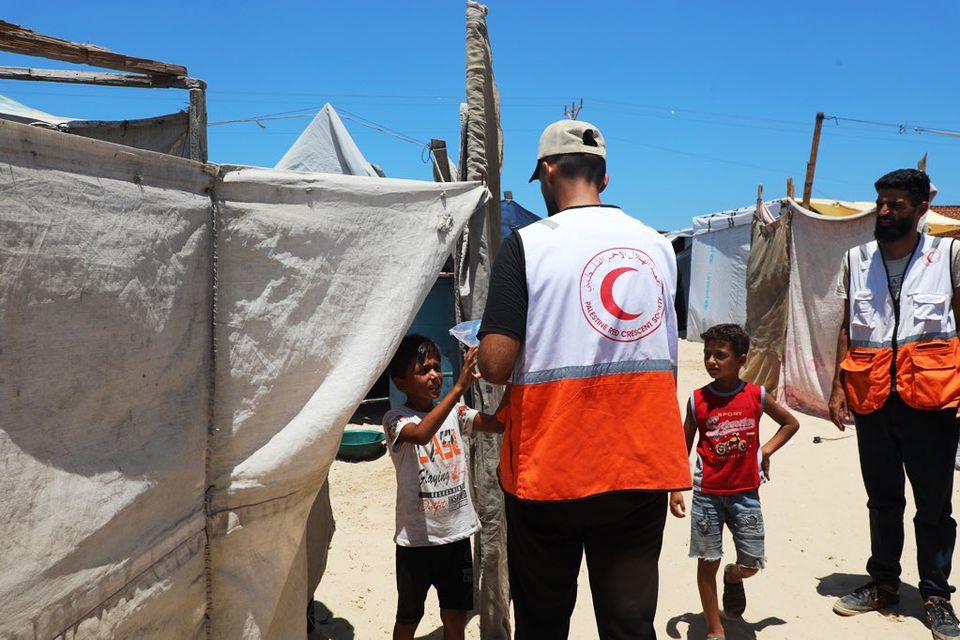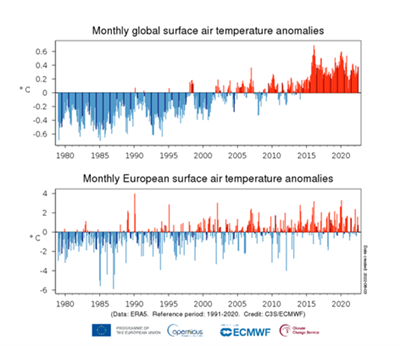Anomaly in surface air temperature for the month of July 2022 compared to the July average for the period 1991-2020. Data source: ERA5. Source: Copernicus Climate Change Service / ECMWF.
Copernicus Climate Change Service (C3S)implemented by the European Center for Medium-Range Weather Forecasts on behalf of the European Commission, routinely publishes monthly climate bulletins that report on changes observed in the global report. surface air temperatureAnd the sea ice And the Hydrological variables. All reported results are based on computer-generated analyzes using billions of measurements from satellites, ships, aircraft and weather stations around the world.
Surface air temperatures in July 2022:
- Globally, July 2022 was one of the three warmest July on record, close to 0.4°C during the 1991-2020 reference period, slightly cooler than July 2019 and marginally warmer than July 2016
- Northern Hemisphere land mass temperatures were well above average
- Temperatures were below average along the western Indian Ocean, from the Horn of Africa to southern India, through most of Central Asia, as well as across most of Australia.
- The sixth warmest July was recorded for Europe as a whole. The heat wave has set local and national records in the western and northern parts of the continent
The state of sea ice in July 2022:
- Antarctic sea ice volume hits lowest value for July in 44 years of records, 7 percent below average and well below the previous record
- The Southern Ocean had large areas of below-average sea ice concentrations from the Amundsen and Bellingshausen Seas to the northern Weddell Sea, as well as most of the Indian Ocean strip of the Southern Ocean.
- Arctic sea ice extent was 4 percent below average. It was the twelfth lowest value on record for July, well above the July lows of 2019-2021
Hydrological conditions in July 2022:
- July 2022 was drier than normal across most of Europe, with locally lower precipitation in the west and dryness in several places in the southwest and southeast.
- The drought affected the local economy and facilitated the spread and intensification of wildfires.
- It was also drier than average across much of North America, South America, Central Asia, and Australia.
- Precipitation is more than usual, especially in eastern Russia and northern China. A large body of rain extended from East Africa through Asia to northwest India.
Monthly global averages and European average temperature anomalies for 1991-2020, January 1979 to July 2022. Darker colored bars indicate July values. Data source: ERA5. Source: Copernicus Climate Change Service / ECMWF.
The Copernican Climate Change Service (C3S) reports on a long heat wave that began in Portugal and Spain and continued north and east toward France, Great Britain, Central Europe, and Scandinavia. Temperatures above 40°C are observed in parts of Portugal, Spain, France and the United Kingdom. Across the affected region, temperature records for July were broken. The Iberian Peninsula experienced an unusually high number of days with maximum temperatures over 35°C, confirming the longevity of heat waves in this region. Southwestern Europe experienced the highest temperatures ever recorded.
Freja Vamborg, Chief Scientist at Copernicus Climate Change Service, comments: “We can expect more frequent and longer periods of extremely high temperatures, with global temperatures increasing even more. Heat waves pose serious health risks and can increase intensity and longevity. Many others Catastrophic weather events, including wildfires and droughts, affecting both society and natural ecosystems, in addition, the combination of pre-existing dry conditions, higher temperatures and lower precipitation may have in many areas during a month July has negative effects in areas such as agricultural production, shipping, and energy production.
More information is available on C3S analysis of heat wave and precipitation deficiency in Europe over here.
Video materials accompanying the maps are available over here.
More information about July weather changes, weather updates from previous months, HD graphics and video can be downloaded here over here.
More information is available over here.
More information about the reference period used is available over here.
Answers to frequently asked questions about temperature monitoring over here.
Information about the C3S dataset and how to collect it
Temperature and hydrology maps and data are from the ERA5 data of the ECMWF’s Copernicus Climate Change Service.
Sea ice maps and data are from a set of information from ERA5, as well as from EUMETSAT OSI SAF Sea Ice Index v2.1 and Sea Ice Concentration CDR/ICDR v2 and Fast Track data provided on request by OSI SAF.
The regional averages listed have the following latitude/longitude limits:
All Earth, 180W-180E, 90S-90N. In total.
Europe, 25W-40E, 34N-72N, by road only.
About Copernicus and ECMWF
Copernicus is part of the European Union’s Space Programme, which is funded by the European Union, the leading Earth observation programme. The company operates through six thematic services: Atmosphere, Marine, Land, Climate Change, Security and Emergencies. It offers freely available operational data and services that provide users with reliable and up-to-date information about our planet and its environment. The program is coordinated and managed by the European Commission and implemented in partnership with Member States, the European Space Agency (ESA), the European Organization for the Exploitation of Meteorological Satellites (EUMETSAT), the European Center for Medium Distance Forecasting (ECMWF), European Union agencies, Mercator Océan and others.
ECMWF operates two services of the European Union’s Copernicus Earth Observation Program: the Copernicus Atmospheric Monitoring Service (CAMS) and the Copernicus Climate Change Service (C3S). They also contribute to the Copernican Emergency Management Service (CEMS), which is implemented by the European Union Joint Research Council (JRC). The European Center for Medium Range Weather Forecasts (ECMWF) is an independent intergovernmental organization supported by 35 countries. It is a 24/7 operational research and service institute that produces and publishes digital weather forecasts to its member states. These data are fully available to the national meteorological services of the member states. The supercomputer facility (and associated data archive) at the ECMWF is one of the largest of its kind in Europe and member states can use 25 percent of its capacity for their own purposes..
ECMWF has expanded the number of sites in which it operates. In addition to the headquarters in the UK and the computing center in Italy, the new offices focusing on activities implemented in partnership with the European Union, such as Copernicus, will be located in Bonn, Germany.
Copernicus Atmospheric Monitoring Service Networkhttp://atmosphere.copernicus.eu/
Copernicus Network for Climate Changehttps://climate.copernicus.eu/
More information about Copernicus:www.copernicus.eu
ECMWF Website:https://www.ecmwf.int/
Twitter:
Tweet embed
Tweet embed
Tweet embed
#EUSspace
Media connection
Nuria Lopez
Communication | Copernicus contracts and the press
General manager’s office
European Center for Medium-Range Weather Forecasts
Reading, UK | Bologna, Italy
Email: [email protected]
Phone: +44 (0) 118949 9778
Mobile: +44 (0) 7392277523
Twitter: Tweet embed
Bjorn Mogensen
Oxenstierna Communication
+46 708-184298
[email protected]
Tags:

“Extreme tv maven. Beer fanatic. Friendly bacon fan. Communicator. Wannabe travel expert.”







More Stories
World's oldest railway bridge to be repaired ahead of its 200th anniversary in UK
Britain botches climate target, leaves EU lagging behind – Hufvudstadsbladet
Sweden to train Ukrainian soldiers – 120 instructors to travel to Great Britain – Hufvudstadsbladet